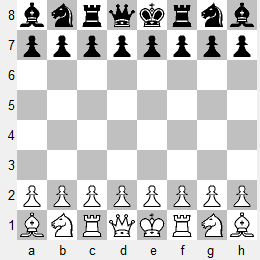
SP323 BNRQKRNB
How do the engines treat this position? I downloaded the corresponding file from the CCRL (see the link on the right sidebar) and found 178 CCRL games. I then loaded the file into SCID and used it to count the intiial moves. SCID doesn't know anything about chess960 -- it chokes when it encounters the first castling move -- but it works properly to that point. The following table shows the output from the SCID 'Tree Window'.
| Move | Frequency | Score | AvElo | Perf | AvYear | %Draws |
| 1: Nf3 | 52: 29.2% | 60.5% | 2622 | 2723 | 2010 | 13% |
| 2: b4 | 34: 19.1% | 61.7% | 2853 | 2907 | 2011 | 24% |
| 3: b3 | 31: 17.4% | 50.0% | 2659 | 2640 | 2010 | 29% |
| 4: Nc3 | 22: 12.3% | 77.2% | 2674 | 2891 | 2011 | 9% |
| 5: c4 | 17: 9.5% | 61.7% | 2712 | 2787 | 2010 | 6% |
| 6: g3 | 12: 6.7% | 41.6% | 2582 | 2529 | 2009 | 17% |
| 7: d4 | 5: 2.8% | 40.0% | 2010 | 0% | ||
| 8: e4 | 4: 2.2% | 37.5% | 2010 | 25% | ||
| 9: g4 | 1: 0.5% 1 | 00.0% | 2007 | 0% | ||
| TOTAL: | 178:100.0% | 58.9% | 2680 | 2745 | 2010 | 17% |
Here is the same for Black after White's most popular move, 1.Nf3.
| Move | Frequency | Score | AvElo | Perf | AvYear | %Draws |
| 1: Nf6 | 19: 36.5% | 60.5% | 2540 | 2472 | 2010 | 26% |
| 2: g6 | 17: 32.6% | 58.8% | 2680 | 2561 | 2010 | 0% |
| 3: c5 | 10: 19.2% | 60.0% | 2709 | 2604 | 2011 | 20% |
| 4: Nc6 | 3: 5.7% | 66.6% | 2012 | 0% | ||
| 5: b6 | 2: 3.8% | 50.0% | 2011 | 0% | ||
| 6: d5 | 1: 1.9% 1 | 00.0% | 2012 | 0% | ||
| TOTAL: | 52:100.0% | 60.5% | 2643 | 2542 | 2010 | 13% |
The most popular sequence for both sides, 1.Nf3 Nf6, follows basic opening principles. The Knight move (1) develops a piece, (2) prepares castling O-O, and (3) blocks the long diagonal in order to develop the corner Bishop without having it exchanged immediately. A look at the other popular first moves reveals other basic opening principles in action.
As long as I'm assigning random names to positions arising from the traditional setup, let's give GM Kasparov credit for the formation with the Knight and Bishop switched: 'RBN*****' or '*****NBR'. Why Kasparov? I introduced the 'double Kasparov formation' (aka the Kasparov position?) in two previous posts, Dog-Tired from Memorizing Openings and Switching Bishops and Knights.

No comments:
Post a Comment